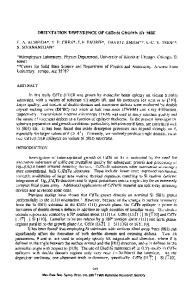Orientation and Velocity Dependence of the Nonequilibrium Partition Coefficient
- PDF / 253,708 Bytes
- 6 Pages / 414.72 x 648 pts Page_size
- 42 Downloads / 355 Views
Abstract Monte Carlo simulations based on a Spin-1 Ising Model for binary alloys have been used to investigate the non-equilibrium partition coefficient (kneq ) as a function of solid-liquid interface velocity and orientation. In simulations of Si with a second component kneq is greater in the [111] direction than the [100] direction in agreement with experimental results reported by Aziz et al. The simulated partition coefficient scales with the square of the step velocity divided by the diffusion coefficient of the secondary component in the liquid.
Introduction During rapid solidification of a binary alloy, the solid-liquid interface is not at equilibrium. The partition (or segregation) coefficient therefore differs from that determined from the equilibrium phase diagram. Rapid solidification leads to the development of novel microstructures and compositions not accessible by standard solidification techniques.
Rapid solidification may be effected by such techniques as laser melting, splat
cooling or melt atomization.[1, 2] Both analytical and computational models have been developed for kneq. The analytical model most extensively compared with experiment is due to Aziz.[3, 4] Jackson has investigated this phenomenon using a computational Spin-I Ising model.45, 6, 7] In addition, orientational dependence of the partition coefficient of Bi in Si during rapid solidification was experimentally investigated by Aziz et a/[8]
Simulations of Solidification of Doped Silicon The probability of an atom going from a liquid to solid is given by: [9] ptLS= P,(tai+. bi)exp(--tS )exp
" z: +)
113
Mat. Res. Soc. Symp. Proc. Vol. 398 01996 Materials Research Society
(1)
'I)i is the bond energy between an atom i and an atom j. The energy of the bond between two atoms depends only on the types of atoms involved, and the relevant phase diagram. (In this paper the liquid was assumed to be an ideal solution, while the solid was assumed to be a regular solution.) The possible types of atoms are solid of species a , solid of species b, liquid of species a, and liquid of species b, which are represented by 'A','B','a', and 'b' respectively. AS is the entropy of fusion, 6 t i is one when atom i is of type t, kB is Boltzmann's constant and T is the temperature. P0 is a constant that will be determined if all the probabilities are to sum to one. Alternatively, if one considers the probabilities to be the likelihood of an event in a particular time interval, P, will determine the time scale. The probability of an atom going from crystal to liquid is given by:
pSL
= P(A +6Bi)exp
(-_ E
(2)
c3)
Diffusion is represented by an exchange between a liquid atom of type 'b' with a liquid atom of type 'a' with the following probability:
(z6-3)
(3)
PDZP= P. %b,
Where F is the diffusive jump frequency, Z is the number of nearest neighbors. This will lead to a diffusion coefficient given by [10]
D
Fa2
(4)
2d
where a is the jump distance to the nearest neighbor and d is the dimensionality of the lattice.
Partition Coefficient Dete
Data Loading...











